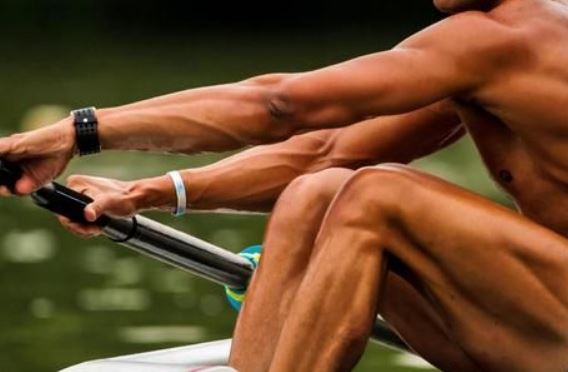The human body has more than 650 muscles, almost all are used during rowing. Let’s have a look at the details.
But what does that actually mean? How do we use them? Let’s see what an expert has to say about that!
Dr. Schmölzer, an Austrian M.D. in sports medicine and 4 time participant at Olympic games, has the following to say. “This is unique and you hardly find that with any other sport,” explains the doctor and quadruple world champion. Most of the work in rowing falls to the legs, but also arms, hips, back and upper body are used intensely, as we all clearly feel afterwards, “In particular, the region around our belly, legs and butt is extremely used. This makes rowing an excellent alternative to aerobics and other full body workouts.” While you’re in the boat your body has to coordinate so many different muscles groups, that you can actually speak of a “muscle management. “When an athlete climbs into the boat for the first time, it is almost impossible for him to carry out the technique in a clean way,” says Schmölzer. “To get a grip on the parallel muscle loops, for example, from the arm to the upper body, hips and legs, takes practice.” The chaining of these muscle movements makes rowing one of the most challenging sports of all. And besides that you must not forget the inner muscles such as the heart and lungs.
One of the biggest challenges in sport – the 2000m rowing race
Juergen Steinacker, Chair of the FISA Sports Medicine Commission explains what the rower is feeling and also where the difference is between a 1000m and a 2000m race. The 2000m rowing race is one of the most physically demanding efforts in the world of sport. Rowers have some of the biggest lung capacities, the highest VO2 maximums and the highest tolerance to the buildup of lactate. So what has just gone on in these rowers’ bodies over those 2000m of racing? (more infos: World Rowing)
But is it true, that the first 100m of a 2000m race are basically “free”? Steinacker confirms this rumour. During the first strokes you are basically just using the energy that is stored in your muscles.
He goes even a step further and says that “the start mainly depends on your muscle size and your efficiency in rowing. If you have more muscle and a good technique, you are quicker at the start.”
What happens in your body after the first strokes on a boat?
The anaerobic energy is limited, so your body has to look for other sources of energy. Therefore, you start breathing heavier and “within 1 minute and 20 seconds you have reached the maximum oxygen consumption, depending on your fitness and your training,” Steinacker says. While your body is adjusting to that, it is building up lactate.
“This lactate comes out of the cells afterwards. Lactate does not go directly into the blood, it needs to be transported. This takes some time,” Steinacker says. So while it’s building up during the second minute, the rower hits the first maximum lactate point after about 3 minutes.
This means, rowers reach after about 3 minutes their maximum oxygen consumption and maximum lactate levels. The only problem with that is, they have to keep that one up. After about 1000m you actually reach your maximum. Thats your full capacity. But then you have to be able to continue. “… and then the real race starts”, says Steinacker.
While you’re not only at your physical maximum, you also reach your mental high point after a while. It’s not like in other sports, a short sprint here and there, or a focus on endurance while not being totally at your limit. It’s reaching your limit for 2000m. You have to give 100% throughout without a break.
So when you reach your maximum after 1000m, there’s another one. This is not only physically demanding, but mentally exhausting as well. Steinacker says that, too much lactate build-up in the first part of the race can actually decrease muscle efficiency as the race continues, meaning that athletes risk losing speed if they give too much effort to the first part of the race.
What does this mean for you if you’re not rowing 2000m but 1000m?
While during the 2000m your ability to keep your limit up is important, in a 1000m competition your personal technique might have a bigger impact. You reach your maximum lactate level but you don’t have to keep it up. And you’re able to recover more quickly.
The 2000m just pushes you deeper into your reserves and requires a better understanding of your body. You have to understand your limit. Your recovery. You have to know, how to keep the perfect movement up, even if your body and all of 650 muscles urge you to stop. In the end it’s not only about training but also about knowing your body, and experiencing and understanding your own limits.
Sources and more infos:
www.worldrowing.com/news/what-happens-the-body-during-rowing-race







